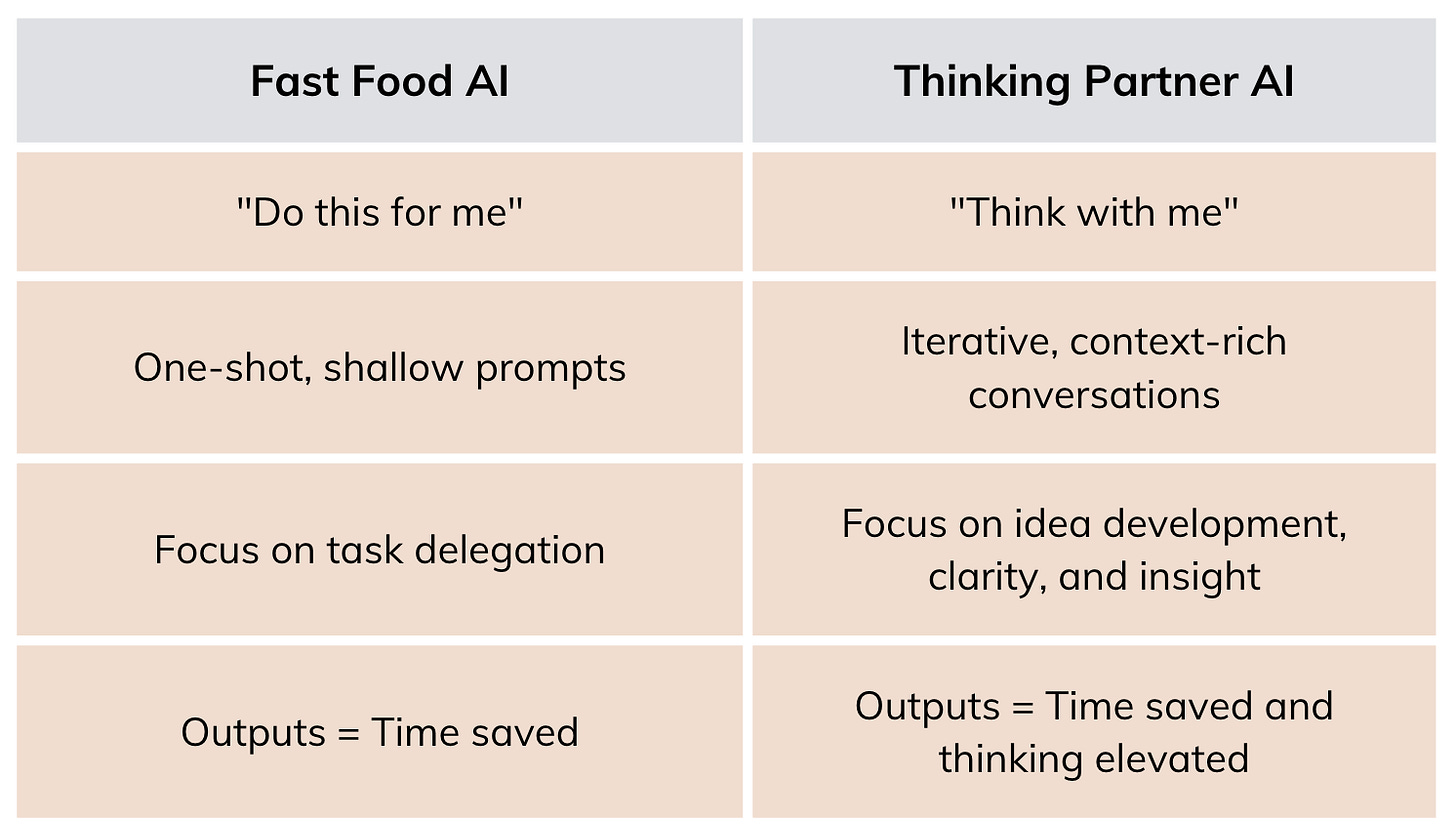The AI Extraction Trap (And Three Ways to Escape It)
Move beyond fast food prompts to genuine AI collaboration that elevates your thinking.

You know that moment when you craft what feels like the perfect AI prompt, hit enter with anticipation, and then... meh. The response is fine. Serviceable. But it sits there on your screen like a stranger's thoughts, disconnected from what you care about.
Maybe the prompt saved you fifteen minutes. Maybe it didn't. Either way, you close the tab with that vaguely hollow feeling, like you just ate intellectual fast food.
I've been there more times than I care to admit.
Type query, get answer, move on. Rinse and repeat.
It's what I'm calling the "extraction mindset"—treating AI like a more sophisticated Google search, a fast food delivery for instant answers.
When we use AI this way, we're not thinking. We're outsourcing our thinking. And our brains know the difference.
So how can we work with AI in a respects how our brains build understanding?
Today’s exploration is to show you practical strategies to integrate AI into your existing workflows in a way that genuinely enhances your thinking, planning, and creative processes.
It's about feeling in control, using AI as a powerful partner that brings clarity, not more cognitive clutter. It's about unearthing more profound insights and designing more effective solutions for the people you work with or serve.
🧠 Thinking Partner vs. Intellectual Fast Food
Think of your brain like that LEGO set. The more bricks (organized knowledge in your long-term memory) you have, the easier it is to build impressive new structures.
Using AI in the "fast food" way, hands you a pre-built LEGO castle. It might look okay from the outside, but you didn't learn how to build it.
A "thinking partner" AI helps you sort your existing bricks and figure out how to connect the new ones. You might end up with a self-built castle or a different structure
When you treat AI like fast food, you extract. You might be able to work faster. But faster might come at the cost of superficiality, disconnected from what you already know.
When you treat it like a thinking partner, you collaborate. You’re engaging, making connections, and essentially making it easier for your brain to do its best work. That unlocks creative insight, depth, and better decisions.
🎯 How To Escape the Fast Food Trap
Let's make this concrete and see how these "thinking partner" approaches connect to the science of learning.
1) From Summarising to Synthesizing Information
❌ Fast Food AI Prompt:
“Summarize this transcript [link/text] in 3 bullet points.”
(Brain impact: Passive consumption. High chance of just getting surface-level points, little connection to your existing knowledge, minimal retention.)
✅ Thinking Partner Prompt:
“I’m trying to synthesize this transcript for a workshop I'm leading for [e.g., social impact founders]. The goal is to highlight practical strategies they can implement immediately. What are the 2-3 most resonant quotes that speak to overcoming common early-stage challenges? Based on the transcript, where might my audience get stuck or have unstated assumptions I should address? What framing could clarify the core insight here, making it truly actionable for them?”
(Brain impact: You're guiding the AI to help you elaborate and make connections – key for encoding in LTM. By asking it to consider your audience and potential misconceptions, you're reducing your own cognitive load in figuring that out from scratch, and focusing your mental energy on the core insights.)
2) From Content Garbage to Idea Development
❌ Fast Food AI Prompt:
“Write a blog post about using AI for productivity.”
(Brain impact: You're asking AI to do the "biologically secondary" skill of writing for you. You might get a post, but you haven't learned much about structuring arguments or communicating effectively.)
✅ Thinking Partner Prompt:
“I want to write a blog post that helps mission-driven solopreneurs use AI to reclaim focus, not just tick off more tasks. Here’s a rough outline I’m thinking: [Your brief outline]. What critical perspectives am I missing, especially regarding ethical AI use or avoiding burnout? What stories, analogies, or metaphors (like the ones I often use, e.g., 'AI as a gym buddy') would make this more memorable and less like generic tech advice? How can I frame this to empower them to use AI wisely, in a way that protects their values?”
(Brain impact: You're using AI to scaffold a complex task. By starting with your outline, you're activating prior knowledge. Asking for help with analogies and framing is a form of elaboration and desirable difficulty – you're pushing your thinking with AI's help, making the final understanding more robust and memorable.)
3) From Tool Curation to Resource Creation
❌ Fast Food AI Prompt:
“Give me 10 AI tools for solopreneurs.”
(Brain impact: Potential information overload! Your working memory can only handle so much. A list doesn't help you learn what's truly useful.)
✅ Thinking Partner Prompt:
“I want to create a short, curated guide of AI tools specifically for [e.g., coaches in the learning and development space]. They're often overwhelmed and want to avoid shiny object syndrome. Instead of just listing features, what’s a smart way to categorize 3-5 tools by the type of strategic thinking they amplify or the kind of deep work they support (e.g., 'AI for unearthing client blind spots,' 'AI for structuring complex project plans,' 'AI for synthesizing research into actionable insights')? For each, suggest one core question a coach could ask it to immediately see its value as a thinking partner.”
(Brain impact: You're using AI to reduce extraneous load and focus attention on what's most important. By categorizing and focusing on "thinking amplified," you're helping your audience (and yourself!) process the information more effectively for long-term use, rather than just presenting a data dump.)
🔁 Key Principles for AI as a Thinking Partner
Making this shift is about changing your approach. Here’s how you can start:
Share Your Context (Generously): Your brain learns best when new information connects to what's already in your long-term memory. Tell AI your goals, your current thinking, or any constraints you have. This helps AI provide relevant connections, reducing the mental effort of trying to fit generic advice into your specific world.
Invite Reflection, Not Just Action: Move beyond "do this" to "help me think about this." Ask: “What am I missing here?” “What are the potential blind spots in this approach?” “How else could I frame this idea for [specific audience]?” This prompts elaboration and helps you spot and fix bad ideas fast, which is key for building an accurate understanding.
Keep the Conversation Going: Learning isn't one-shot; it's iterative. Treat AI interactions like a collaborative whiteboard session. Refine, question, challenge.
Prioritize Elevation Over Delegation: The real magic happens when you use AI not just to do things, but to help you think better. This creates "desirable difficulty." Use AI to see your own ideas from new angles, sharpen your arguments (like a Socratic tutor), explore adjacent possibilities, and stress-test your assumptions. You’re doing the mental reps, with AI as your spotter.
The Shift That Matters
The idea of AI augmenting human intelligence—helping us see blind spots, stress-test ideas, and achieve deeper insights—is powerful. It connects directly to our innate curiosity and our desire to learn and innovate.
Your brain knows the difference between real understanding and borrowed brilliance. Between earned insight and an effortless illusion.
AI is like the world’s smartest GPS. It gives you detailed maps, suggests the best routes, flags hazards, and even drafts reports from afar. But it can’t walk the path for you. It can’t feel the terrain, meet the locals, or choose which unknown trail is worth your time.
That’s your job.
You’re the explorer.
AI helps, but only you can turn the journey into a discovery.
When you shift from treating AI as a fast food delivery service to a thinking partner, you’re elevating how you engage with complexity, how you develop your ideas, and ultimately, how you bring your best, most deeply understood work into the world. And that’s a partnership that helps you learn, grow, and amplify your impact.
What's your go-to 'thinking partner' prompt?






Eva, your story is excellent, defining AI as a useful tool. After barely trying it in my writing, I’m ready to experiment to see how it can improve my work. Thank you.